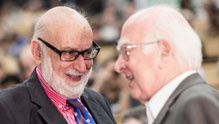|
Peter W Higgs, a British scientist who proposed the existence of the Higgs boson, or 'God Particle', and Belgian physicist Francois Englert, who developed the same theories about sub-atomic particles and mass, have jointly won this year's Nobel Prize for Physics.  | | Apollo François Englert and Peter Higgs. Photo: © CERN | Peter W Higgs of the University of Edinburgh, UK and François Englert of the Université Libre de Bruxelles, Brussels, Belgium share the prestigious accolade and £780,000 cash prize. Their discoveries were recently confirmed through the discovery of the predicted fundamental particle, by the ATLAS and CMS experiments at CERN's Large Hadron Collider, the Nobel Prize committee said in a release. The two were honoured for "the theoretical discovery of a mechanism that contributes to our understanding of the origin of mass of sub-atomic particles, and which recently was confirmed through the discovery of the predicted fundamental particle," the Nobel Prize jury said. Peter W Higgs and François Englert (together with his now deceased colleague Robert Brout) proposed the theory independently of each other as far back as in 1964 and their ideas were confirmed in 2012 by the discovery of a so-called Higgs particle at the CERN laboratory outside Geneva in Switzerland. The awarded theory is a central part of the Standard Model of particle physics that describes how the world is constructed. According to the Standard Model, everything, from flowers and people to stars and planets, consists of just a few building blocks: matter particles. These particles are governed by forces mediated by force particles that make sure everything works as it should. The entire Standard Model also rests on the existence of a special kind of particle: the Higgs particle. This particle originates from an invisible field that fills up all space. Even when the universe seems empty this field is there. Without it, we would not exist, because it is from contact with the field that particles acquire mass. The theory proposed by Englert and Higgs describes this process. On 4 July 2012, at the CERN laboratory for particle physics, the theory was confirmed by the discovery of a Higgs particle. CERN's particle collider, LHC (Large Hadron Collider), is probably the largest and the most complex machine ever constructed by humans. Two research groups of some 3,000 scientists each, ATLAS and CMS, managed to extract the Higgs particle from billions of particle collisions in the LHC. Even though it is a great achievement to have found the Higgs particle - the missing piece in the Standard Model puzzle - the Standard Model is not the final piece in the cosmic puzzle. One of the reasons for this is that the Standard Model treats certain particles, neutrinos, as being virtually massless, whereas recent studies show that they actually do have mass. Another reason is that the model only describes visible matter, which only accounts for one fifth of all matter in the cosmos. To find the mysterious dark matter is one of the objectives as scientists continue the chase of unknown particles at CERN. François Englert, a Belgian citizen, was born in 1932 in Etterbeek, Belgium. Professor Emeritus at Université Libre de Bruxelles, Brussels,he also holds a Ph.D from the university. Peter W Higgs, a UK citizen, was born in 1929 in Newcastle upon Tyne, UK. Professor Emeritus at the University of Edinburgh, UK, Higgs holds a PhD from King's College, University of London, UK.
|